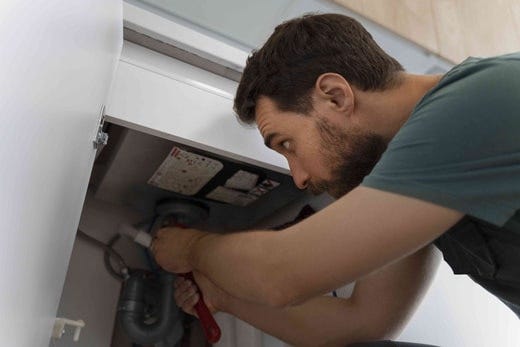How to Install Dishwasher Drain Hose

Dishwashers are intricate appliances, and any misstep in their installation could lead to a host of issues, from potential flooding to unclean dishes and noisy wash cycles. It's crucial to install the dishwasher drain hose correctly to avoid these problems.
Installing a dishwasher drain hose is a vital step that must be executed correctly. It ensures that the dirty water is directed into your drain system, maintaining a clean and functional kitchen.
If your sink has a garbage disposal, connect the hose to the dishwasher discharge inlet on the disposal housing. If you don’t have a garbage disposal, you’ll connect the dishwasher drain hose directly to the discharge port on the drain assembly.
Whether you're installing a new dishwasher or replacing an old hose, use the guidelines provided in our "How to Install a Dishwasher Drain Hose" article for a safe and effective installation process.
What you’ll need
- Screwdrivers
- Utility knife
- 7/8-inch (inside diameter) drain hose
- Hose clamps
- Y-branch drain tailpiece (if needed)
- Garbage disposal drain adapter (if needed)
- Pipe clamp or pipe strapping (if needed)
Installing dishwasher drain hose
The different drain hose installation variations you may encounter include:
1. Drain connection with air gap and garbage disposal
When utilizing an air gap fitting, two drain hose lengths are necessary: the dishwasher's factory drain hose stretches from the dishwasher to the smaller tailpiece on the air gap, while a 7/8-inch (inside diameter) hose extends from the other tailpiece on the air gap to the dishwasher nipple on the garbage disposal.
1. Connect the hose to the air gap
Trim the dishwasher drain hose to the required length using a utility knife, ensuring it reaches the smaller tailpiece on the air gap fitting located on the countertop or sink deck. Securely attach this hose to the air gap using a hose clamp.
2. Connect the hose to the garbage disposal
Connect the larger end of the air gap to the garbage disposal using a ⅞-inch rubber hose, securing both ends of the hose with hose clamps—one on the air gap and the other on the garbage disposal's inlet nipple.
2. Drain connection with air gap but no garbage disposal
When attaching a dishwasher drain to an air gap without garbage disposal, the drain hose is indirectly linked to the sink drain via the air gap.
1. Connect the hose to the air gap
Start by connecting the dishwasher drain hose to the smaller end of the air gap, which is installed on the countertop or sink deck. You may need to apply pressure to slide the hose onto the air gap fitting.
2. Connect the hose to the drain pipe
Next, connect the larger end of the air gap to the Y-branch tailpiece on the sink drain by using a ⅞-inch rubber hose. If your drain lacks this tailpiece, installation is required. Y-branch tailpieces come in two sizes, so ensure you acquire the size compatible with the ⅞-inch hose linked to the air gap.
3. Secure with hose clamps
Use hose clamps to secure both ends of the hose to their respective tailpieces. Before fastening the hose with clamps, ensure there are no bends or twists in the tubing. If the hoses are excessively long, trim them to the appropriate size.
3. Drain connection using a high loop to garbage disposal
Before setting up this type of dishwasher drain connection, verify that the local building codes permit the high loop method as an alternative to using an air gap. Note that in certain areas, the high-loop method may not be permissible.
1. Prepare the drain hose
Pull as much of the drain hose as possible from behind the dishwasher. This excess hose is necessary to form the high loop before linking the dishwasher hose to the garbage disposal.
2. Loop the drain hose
Lift the dishwasher drain hose and strap it as close to the top as possible beneath the sink. This elevated loop prevents wastewater from flowing back into the dishwasher from the garbage disposal. You can use a sizable pipe clamp or a section of flexible pipe strapping to anchor the hose either to the underside of the countertop or to the wall adjacent to the countertop.
3. Connect the hose
Attach the dishwasher drain tube directly to the garbage disposal with hose clamps. To make the transition from the hose to the garbage disposal, you may need a dishwasher connector fitting.
One end of the connector attaches to the smaller drain hose, and the other end has a larger ⅞ inch fitting that attaches to the garbage disposal.
4. Drain connection using a high loop to garbage disposal
Once again, verify once more with your local building codes to ensure that the high loop method complies with regulations in your area.
1. Loop the drain hose
Extract as much of the drain line as feasible from behind the dishwasher, then create a high loop under the sink and secure it in position. This precautionary measure prevents sink drain wastewater from siphoning back into the dishwasher.
2. Attach the hose to the sink drain
Attach the end of the dishwasher drain line to the Y-branch tailpiece on your drain, securing it with a hose clamp. Y-branch tailpieces are available in sizes that match your dishwasher drain hose.
.png?width=70&height=45&format=png&quality=50)